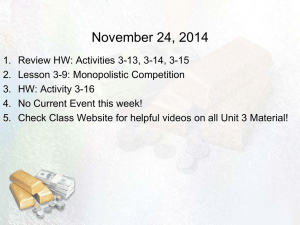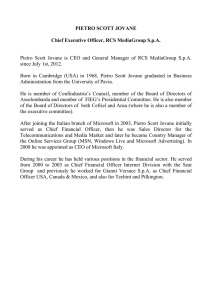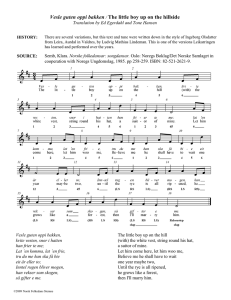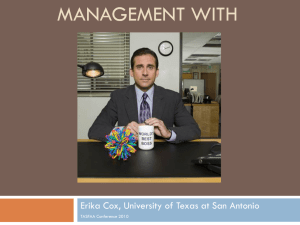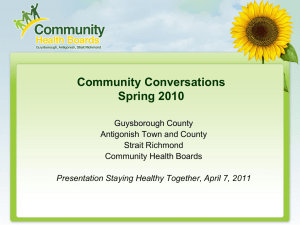(or not know) About Plantar Fasciitis
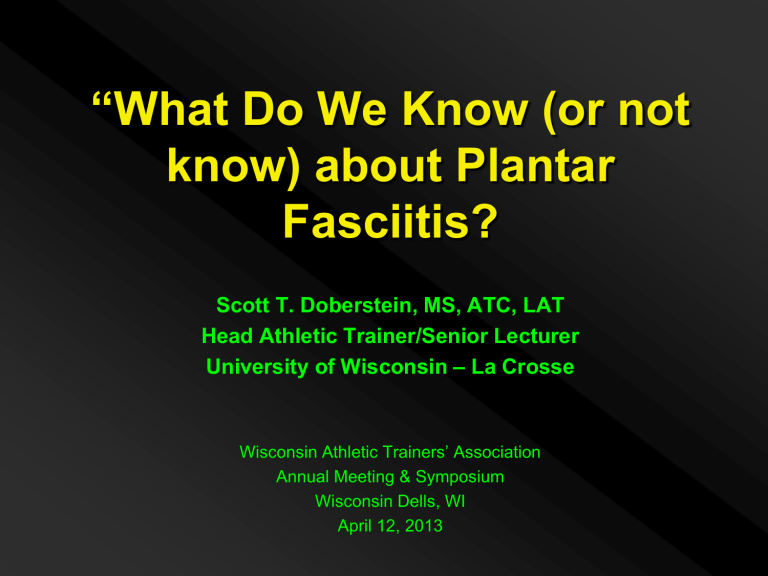
“What Do We Know (or not know) about Plantar
Fasciitis?
Scott T. Doberstein, MS, ATC, LAT
Head Athletic Trainer/Senior Lecturer
University of Wisconsin – La Crosse
Wisconsin Athletic Trainers’ Association
Annual Meeting & Symposium
Wisconsin Dells, WI
April 12, 2013
Graphic
THE FOLLOWING PRESENTATION HAS BEEN APPROVED FOR
[PROFESSIONAL AUDIENCES]
By the Wisconsin Athletic Trainers’ Association
THIS PRESENTATION HAS NOT YET BEEN RATED
Overview…
where are we headed?
Background
Anatomy/Pathophysiology
Etiology
Differential Diagnosis
Classic Presentation
Treatment Interventions
Prognosis
© Scott T. Doberstein, MS, ATC, LAT
Background (What it is!)
PF most common cause of heel pain
• 2 million pts seek Tx annually in US
(Riddle,
2003)
• PF accounts for 11-15% of all foot S/S seeking professional care
(Buchbinder, 2004)
• 10% of running related injuries
( Buchbinder, 2004)
PF most common condition Tx by podiatric foot/ankle specialists
(APMA, 2001)
© Scott T. Doberstein, MS, ATC, LAT
Background (What it is!)
1/3 of pts have bilateral PF
(Neufeld, 2008)
10% probability of getting PF in lifetime
(Crawford, 2003)
Peak age of incidence is 40-60 y, especially women
(Riddle, 2003)
© Scott T. Doberstein, MS, ATC, LAT
Background (What it isn’t!)
1812 – Wood first to describe PF as infection secondary to TB
(Neufeld, 2008)
Fascial layer – not a tendon but…
Interesting tissue to treat!!
© Scott T. Doberstein, MS, ATC, LAT
What is Plantar Fasciitis?
RECALCITRANT*
HEEL PAIN!!
*(difficult to treat; resistant to commonly used treatments, Taber’s 2013)
© Scott T. Doberstein, MS, ATC, LAT
Other names for Recalcitrant heel pain (What it is?)
Painful heel syndrome
Runner’s heel
Jogger’s heel
Tennis heel
Subcalcaneal pain
Calcaneodynia
Plantar faschiopathy
PLANTAR FASCIOSIS (new school)*
© Scott T. Doberstein, MS, ATC, LAT
Other names for Recalcitrant heel pain (What it isn’t?)
Heel spur syndrome
Calcaneal periostitis
PLANTAR FASCIITIS (old school)*
© Scott T. Doberstein, MS, ATC, LAT
Anatomy/Pathophysiology
PF function = provide support to med long arch, dynamic shock absorber
Windlass Effect = tensile force at proximal attachment with MTP extension
PF is INFLEXIBLE – max elongation of 4%
(Lee,2007)
~ Age 40 – calcaneal fat pad breaks down = less shock absorption more force on PF attachment
(Lee, 2007)
© Scott T. Doberstein, MS, ATC, LAT
Anatomy/Pathophysiology
Actually continuous with the Achilles tendon
Is it inflammation? Only acutely??
Most of what we deal with is actually chronic!
Lemont, 2003 = chronic degeneration
• Resection of PF shows histological evidence of PLANTAR FASCIOSIS not fasciitis!
© Scott T. Doberstein, MS, ATC, LAT
Anatomy/Pathophysiology
Lemont, 2003 reported:
• Collagen necrosis and loss of collagen continuity
• Increased ground substance
• Increased vascularity
• Increased fibroblasts
• No inflammation markers or cells (similar to tendinosis)
Caused by repetitive microtears of PF that overtake the body’s ability to repair itself
© Scott T. Doberstein, MS, ATC, LAT
Etiology = MULTIFACTORIAL
RISK FACTORS REPORTED:
Decreased ankle DF ROM
Obesity
Prolonged standing
Pes planus (excessive pronation)
Seronegative arthritis
© Scott T. Doberstein, MS, ATC, LAT
Etiology = MULTIFACTORIAL
Running is a risk factor:
• Increased distance/intensity
• Poor footwear
• Unyielding surface
• Pes cavus
• Shortened Achilles tendon
© Scott T. Doberstein, MS, ATC, LAT
Etiology – What it isn’t!
Heel Spur – significant evidence that bony exostosis does not cause PF
• However, quite common to have an exostosis simultaneously with PF but…the spur is NOT the cause of PF
© Scott T. Doberstein, MS, ATC, LAT
Differential Diagnosis
(What it isn’t!)
Neurologic
(tarsal tunnel syndrome, lateral plantar n. entrapment, medial calcaneal n. entrapment, peripheral neuropathy,
S1 radiculopathy)
Soft tissue
(PF rupture, enthesopathies, fat pad atrophy,
Achilles tendinitis, flexor hallucis longus tendinitis, posterior tibialis tendinitis, plantar fibromatosis)
Skeletal
(calcaneal stress fracture, bone contusion, infection
(osteomyelitis, etc), subtalar arthritis, inflammatory arthropathies)
Miscellaneous
(neoplasm, vascular insufficiency, osteomalacia , Paget’s disease, sickle cell disease)
© Scott T. Doberstein, MS, ATC, LAT
Classic Presentation
(What it is!)
Inferior heel pain (self limiting!)
Increased pain w/ first steps in morning =
Post Static Dyskinesia
(McNally, 2010)
Increased pain upon standing after prolonged sitting
Increased pain during prolonged standing
Increased pain with barefoot walking
Pain worsens near end of the day
© Scott T. Doberstein, MS, ATC, LAT
Classic Non-Presentation
(What it isn’t!)
Inferior heel pain with multi-joint pain or other ligament/tendon pain
Nocturnal pain
Foot pain anywhere besides medial tubercle or medial longitudinal arch
Radiating or neurological S/S
© Scott T. Doberstein, MS, ATC, LAT
Treatment Options Reported
Rest/modification of activity
Ice
Heat
Ultrasound
E-stim
Iontophoresis
Strengthening
© Scott T. Doberstein, MS, ATC, LAT
Treatment Options Reported
Massage
NSAID’s
Stretching (both calf and PF specific)
Night splints
Heel cups/pads
Taping
Casts
© Scott T. Doberstein, MS, ATC, LAT
Treatment Options Reported
Orthoses (custom and off the shelf)
Injections (corticosteroids, PRP, botulinum toxin)
Accupuncture
Shockwave therapy
Magnets
Nutritional Considerations
Surgery
© Scott T. Doberstein, MS, ATC, LAT
Evidence - Based Outcomes
20-30 interventions out there being used
Difficult to research with RCT’s
• Many management strategies are used simultaneously = too many variables
© Scott T. Doberstein, MS, ATC, LAT
Evidence - Based Medicine
Grades of Evidence (McPoil, 2008)
A = strong evidence
B = moderate evidence
C = weak evidence
D = conflicting evidence
E = theoretical/foundational evidence
F = expert opinion
© Scott T. Doberstein, MS, ATC, LAT
Evidence - Based Outcomes
(McPoil, 2008)
Most significant risk factors are limited DF
ROM and obesity B
S/S including pain in plantar medial heel, post static dyskinesia, prolonged standing, pain w/ initial steps following inactivity B
Evaluation findings including decreased DF
ROM, palpable pain at proximal PF attachment, + Windlass test B
© Scott T. Doberstein, MS, ATC, LAT
Evidence - Based Outcomes
(McPoil, 2008)
Iontophoresis (dexamethasone or acetic acid)
B
• Only short term relief of 2-4 weeks
Manual Therapy (specific ankle/foot/MTP joint mobilizations)
E
Taping (calcaneal and low dye)
C
• Only short term relief of 7-10 days
© Scott T. Doberstein, MS, ATC, LAT
Evidence - Based Outcomes
(McPoil, 2008)
Stretching (both calf/Achilles and PF specific)
B
• ST relief for 2-4 months
• Remember Achilles and PF have continuous fibers!
Orthoses (both custom and prefabricated)
• ST relief for ~ 3 months A
• LT relief at 1year F
© Scott T. Doberstein, MS, ATC, LAT
Evidence - Based Outcomes
(McPoil, 2008)
Night Splints (posterior, anterior, sock type)
• Only use after 6 months of S/S and use only for
1-3 months B
NSAID’s – no RCT studies at all E, F
Injections (corticosteroids only) C
• Only ST relief up to 2 weeks
• Significant risk of PF rupture (better with US guided technique)
© Scott T. Doberstein, MS, ATC, LAT
Other Interventions
Extracorporeal Shock Wave Therapy C
Autologous Platelet Rich Plasma C
It’s the SHOES (ADL’s vs. activity) E,F
Nutritional Considerations
(Roxas, 2005)
E, F
• Vitamin C
• Zinc
• Glucosamine
• Bromelain
(pineapple enzyme)
• Fish oil
CT repair/regen anti-inlam
© Scott T. Doberstein, MS, ATC, LAT
What does all this mean for us as clinicians treating patients with plantar fasciosis/fasciopathy?
© Scott T. Doberstein, MS, ATC, LAT
What it isn’t!
Where science meets art….???
OR
© Scott T. Doberstein, MS, ATC, LAT
What is it?
Where art meets science…….??
“No evidence strongly supports the effectiveness of any treatment of PF, and most patients improve without specific therapy or by using conservative measures.”
(Cole, 2005)
© Scott T. Doberstein, MS, ATC, LAT
Intervention Algorithms?
x4
Young, 2001
1. Correct training errors, relative rest, ice post activity, inspect footwear
2. Correct biomechanical factors with stretching and strengthening
3. Night splints and orthotics
4. All other Tx options considered
NSAID’s used throughout Tx but… pt educated that meds are used for pain control and not curative!
© Scott T. Doberstein, MS, ATC, LAT
Intervention Algorithms?
Cole, 2005
1. Shoe inserts, stretching, NSAID’s, ice
(because it works for other musculoskeletal conditions making it reasonable to do)
2. Corticosteroid injection or dexamethasone iontophoresis
3. Night splints, ESWT (but only for runners w/ S/S
> 1 year)
4. Possible surgery
© Scott T. Doberstein, MS, ATC, LAT
Intervention Algorithms?
Neufeld, 2008
1. ADL’s as tolerated, NSAID’s , heel pads, prefabricated orthotics, calf & PF stretching, night splint, pt assured surgery uncommon, dispel myths about heel spur not causing PF,
4-6 weeks
2. Corticosteroid injection followed by cast or cam walker
3. Custom orthoses w/ deep heel cup, Rx strength NSAID’s, lateral x-ray to r/o other pathology cont.
© Scott T. Doberstein, MS, ATC, LAT
Intervention Algorithms?
Neufeld, 2008
4. Continue above if improvement is progressing d/c
5. If no improvement, MRI to confirm PF, ESWT or other alternative Tx
6. Surgery if S/S > 1 year
© Scott T. Doberstein, MS, ATC, LAT
Intervention Algorithms?
Rompe, 2009
1. R/O neuro and osseous pathologies
2. PF specific stretching for 6-12 weeks
3. continue stretching, modify activity, soft heel pads for another 6-12 weeks
4. continue above, night splints, ionto 6-12 wks
5. continue above, ESWT, corticosteroid injection
6. botulinum toxin
7. Surgery after 6-12 months of unsuccessful mgmt
© Scott T. Doberstein, MS, ATC, LAT
Prognosis
Hastened recovery if Tx initiated w/in 6 wks of onset
(Young, 2001)
Non-surgical mgmt success rate = 90%
(Neufeld, 2008)
80% of pts have favorable results w/in 12 months
(Rompe, 2009)
© Scott T. Doberstein, MS, ATC, LAT
Further Research
We need more research on many interventions to get a better handle on this significant problem!!!
On the horizon…..??
• Injections of botulinum toxin
• Injections of autologous platelet rich plasma
• Anything else you can think of??????
© Scott T. Doberstein, MS, ATC, LAT
Thank You
Enjoy the rest of the
Symposium!
© Scott T. Doberstein, MS, ATC, LAT

